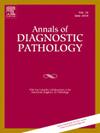Acellular mucin in non-neoplastic inflammatory conditions of lower gastrointestinal tract
IF 1.4
4区 医学
Q3 PATHOLOGY
引用次数: 0
Abstract
Purpose
In the context of neoplasia, acellular mucin in lower gastrointestinal (GI) tract implies occult mucin-producing tumor and warrants additional workup. The clinical significance of acellular mucin in benign conditions remains unclear.
Methods
Lower GI tract surgical specimens with acellular mucin without documented neoplastic conditions (colonic diverticulitis (n = 16), appendicitis (n = 14), and others (n = 8)) were retrieved. Low grade appendiceal mucinous neoplasm (LAMN) (n = 24) and diverticulitis without acellular mucin (n = 28) were used as controls for appendicitis and diverticulitis cases, respectively. Clinical data, histological findings, and additional workups performed due to acellular mucin were collected.
Results
Patients with appendicitis with acellular mucin frequently presented with signs and symptoms of acute appendicitis (p = 0.016) compared to LAMN. 71 % were interval appendectomy, and 57 % had diverticula. In colonic diverticulitis cohort, no differences were found in terms of the duration of symptoms, age, gender and the degree of inflammation between the groups with and without acellular mucin. Seven of 8 patients with other conditions with acellular mucin had a history of abdominal surgery or fistula. Additional workup included levels (n = 7), consults (n = 11), and stains (n = 4).
Conclusion
Acellular mucin can be seen in a variety of benign conditions but this phenomenon is probably under-recognized and leads to additional investigations. Acellular mucin is likely translocated from the lumen through diverticulum or mural defect. Considering clinical context is crucial in providing accurate diagnosis while preserving laboratory resources.
下胃肠道非肿瘤性炎症条件下的脱细胞粘蛋白
目的:在肿瘤的背景下,下胃肠道(GI)的脱细胞黏液蛋白暗示了潜在的产生黏液蛋白的肿瘤,需要进一步的检查。脱细胞粘蛋白在良性疾病中的临床意义尚不清楚。方法收集无肿瘤记录(结肠憩室炎(n = 16)、阑尾炎(n = 14)和其他(n = 8))的无细胞粘蛋白的慢速胃肠道手术标本。以低级别阑尾黏液性肿瘤(LAMN) (n = 24)和无脱细胞黏液性憩室炎(n = 28)为对照,分别为阑尾炎和憩室炎病例。收集了临床资料、组织学结果和因脱细胞黏液蛋白而进行的额外检查。结果合并脱细胞黏液蛋白的阑尾炎患者出现急性阑尾炎的症状和体征较多(p = 0.016)。间期阑尾切除术占71%,憩室切除术占57%。在结肠憩室炎队列中,有无脱细胞粘蛋白组在症状持续时间、年龄、性别和炎症程度上均无差异。8例伴有脱细胞黏液蛋白的患者中有7例有腹部手术或瘘管病史。附加检查包括水平检查(n = 7)、咨询检查(n = 11)和染色检查(n = 4)。结论脱细胞粘蛋白可以在各种良性疾病中看到,但这种现象可能未被充分认识,需要进行额外的检查。脱细胞粘蛋白可能通过憩室或壁缺损从管腔转移。在保留实验室资源的同时,考虑临床情况对提供准确诊断至关重要。
本文章由计算机程序翻译,如有差异,请以英文原文为准。
求助全文
约1分钟内获得全文
求助全文
来源期刊
CiteScore
3.90
自引率
5.00%
发文量
149
审稿时长
26 days
期刊介绍:
A peer-reviewed journal devoted to the publication of articles dealing with traditional morphologic studies using standard diagnostic techniques and stressing clinicopathological correlations and scientific observation of relevance to the daily practice of pathology. Special features include pathologic-radiologic correlations and pathologic-cytologic correlations.

 求助内容:
求助内容: 应助结果提醒方式:
应助结果提醒方式:


